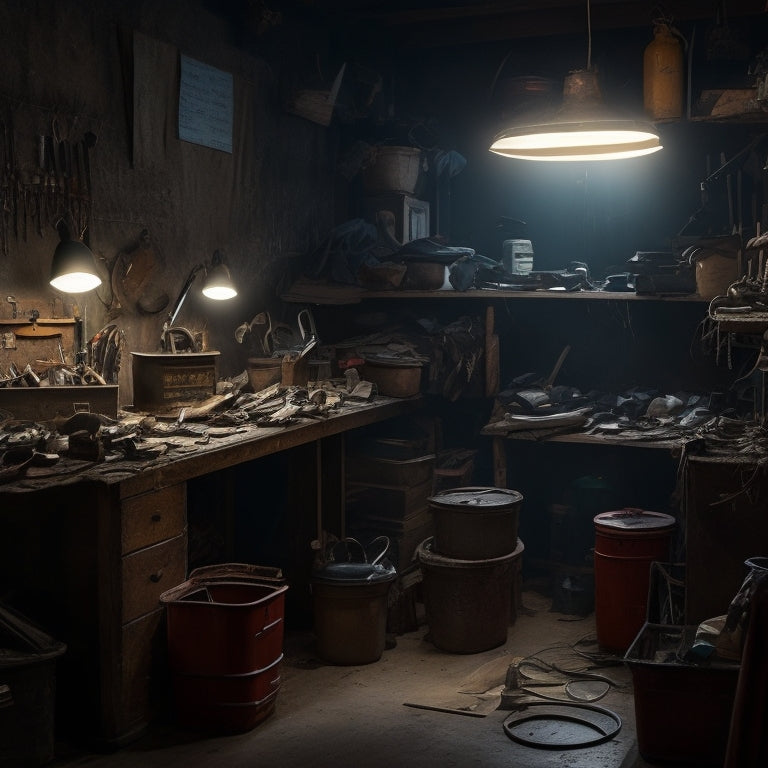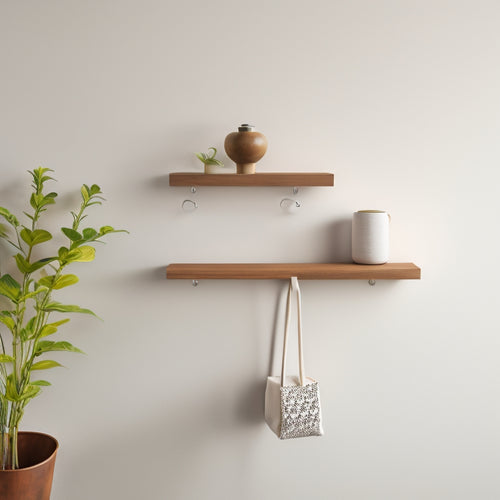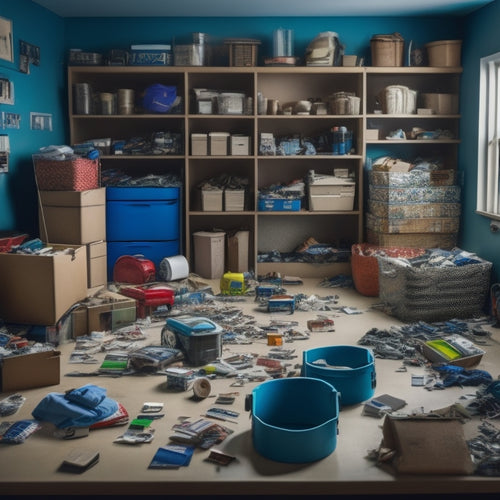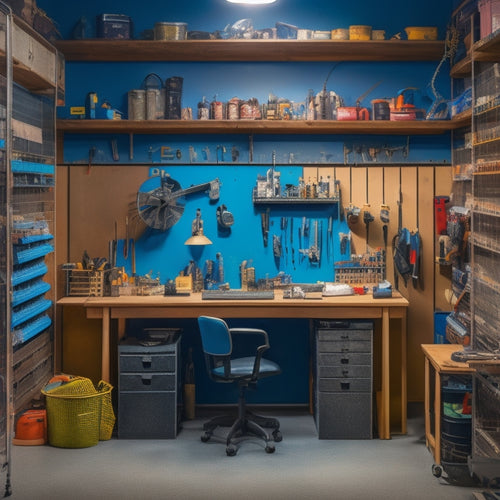
Why Cluttered Workshops Are Holding You Back
Share
You're wasting valuable time searching for tools and supplies in your cluttered workshop, and safety risks are lurking in the shadows. Disorganization affects your mental clarity, making it tough to focus on projects. Inefficient use of space means you're not maximizing your workshop's potential. To make matters worse, clutter damages tools and equipment, causing stress levels to skyrocket. It's time to take control of your workshop. By implementing simple organization strategies and decluttering methods, you can transform your space and release your productivity. Now, get ready to discover the secrets to a more efficient, stress-free workshop.
Key Takeaways
• Cluttered workshops lead to wasted time searching for tools and supplies, hindering productivity and efficiency.
• Disorganized spaces pose safety risks, increase stress levels, and decrease mental clarity, affecting overall well-being.
• Inefficient use of workshop space and lack of organization strategies result in damage to tools and equipment, further reducing productivity.
• A cluttered workshop environment can cause distractions, making it difficult to focus on projects and leading to decreased quality of work.
• Failure to implement organization techniques and decluttering methods can lead to a significant decrease in overall workshop performance and output.
Cluttered Workshops Kill Productivity
Frequently, you find yourself wasting valuable time searching for misplaced tools or supplies in a cluttered workshop, which hampers your productivity. This is a common issue many workshop owners face, but addressing this is crucial to maximize your output.
To overcome this, implement effective organization strategies and decluttering techniques. Start by categorizing your tools and supplies, and assign a designated spot for each item. This will help you quickly locate what you need, saving you time and energy.
Additionally, consider investing in storage solutions such as shelves, bins, and hooks to keep your workspace tidy. By doing so, you'll create a more efficient workspace that allows you to focus on the task at hand.
With a clutter-free workshop, you'll experience a significant boost in productivity. You'll be able to complete projects faster, take on more clients, and ultimately increase your revenue.
Safety Risks in Disorganized Spaces
How can you expect to work safely when tripping hazards, sharp objects, and falling tools are lurking around every corner in your cluttered workshop? Disorganization in your workspace creates an environment conducive to accidents, putting you and others at risk of injury.
A cluttered workshop is a breeding ground for safety hazards, making it vital to prioritize organization tips to mitigate these risks.
To enhance workspace efficiency and reduce clutter management challenges, start by designating a specific place for each tool and material. Label storage bins and shelves to guarantee easy identification and retrieval. Implement a 'clean as you go' policy to prevent debris and scraps from accumulating. Consider investing in tool organizers, pegboards, and hooks to maximize storage capacity.
Time Wasted Searching for Tools
You're wasting valuable time searching for tools and supplies in your cluttered workshop, only to find them buried under piles of scraps or misplaced in a random drawer. This constant searching eats away at your productivity, causing frustration and delays.
A well-organized workshop, on the other hand, saves you time and energy. With a solid tool organization system in place, you can quickly locate the tools you need, getting back to work faster.
Effective time management is pivotal in a workshop, and clutter is a major obstacle to achieving it. By implementing a system for storing and categorizing your tools, you'll be able to allocate your time more efficiently.
Imagine having all your tools within easy reach, allowing you to focus on the task at hand. You'll complete projects faster, meet deadlines, and even have time to take on more work.
Clutter Affects Mental Clarity
You know how it feels when your workshop is cluttered - it's overwhelming and stressful. That's because clutter doesn't just clutter your space, it also clouds your mind.
When your surroundings are disorganized, you're more likely to feel anxious and struggle to focus, which slows your progress and hinders your creativity.
Clutter Clouds the Mind
Clutter's disordered presence in your workshop seeps into your mind, making it difficult to focus on the task at hand. When you're surrounded by clutter, it's simple to feel overwhelmed and stuck in a mental haze. The disorder chaos can be distracting, causing your brain to constantly juggle tasks and making it hard to prioritize tasks.
As a result, your creativity becomes blocked, and you struggle to come up with inventive solutions.
A cluttered workshop can lead to mental exhaustion, making it challenging to make decisions and solve problems. With a cluttered mess surrounding you, it's simple to feel anxious and stressed, which can further cloud your judgment. Furthermore, clutter can make you feel like you're drowning in a sea of disarray, making it difficult to stay motivated and focused.
To break free from this cycle, it's crucial to create a workspace that promotes clarity and tranquility. By clearing out the clutter and organizing your tools and materials, you can quiet your mind and unleash your full potential.
With a clear and organized workspace, you'll be able to think more clearly, stay focused, and tap into your creativity.
Disorganization Slows Progress
Surrounded by disorganization, progress slows to a crawl as your mental clarity is compromised, making it increasingly difficult to stay on track with projects and meet deadlines. This is because cluttered workshops lead to mental clutter, making it hard to focus on the task at hand. As a result, you're left feeling overwhelmed, stressed, and struggling to make progress.
To break free from this cycle, implementing effective organization techniques is crucial. Start by categorizing your tools and materials, assigning a designated space for each item, and labeling them for easy identification. This will help you quickly locate what you need, saving you time and energy.
Additionally, prioritize tasks using time management strategies, such as the Pomodoro Technique, to help you stay focused and on track. By streamlining your workspace and workflow, you'll be able to tackle projects with clarity and confidence, ultimately leading to increased productivity and success.
Inefficient Use of Workshop Space
Inadequate storage solutions and poorly planned layouts are suffocating your workshop's potential, forcing you to waste valuable time moving through a maze of tools and materials. This inefficient use of space isn't only frustrating but also hinders your ability to serve others effectively.
To optimize your workshop space, consider the following strategies:
-
Designate zones: Assign specific areas for specific tasks, such as a woodworking zone or a painting zone, to improve workflow efficiency.
-
Implement vertical storage: Maximize your ceiling height by using wall-mounted shelves, hooks, and bins to store infrequently used items, keeping them out of the way but still accessible.
-
Create a 'golden zone': Position your most frequently used tools and materials in an easily accessible area, reducing the time spent searching for them and increasing your overall productivity.
Difficulty Finding Essential Items
You've wasted hours searching for that one specific drill bit or socket, only to find it buried beneath a pile of scattered tools and materials. This frustrating scenario is all too familiar when working in a cluttered workshop.
The consequences of disorganization go beyond mere annoyance – it's a productivity killer. When you can't find what you need, projects stall, and deadlines are missed.
To overcome this hurdle, implement effective organization solutions and decluttering strategies. Start by categorizing tools and materials, assigning a designated spot for each item. Utilize storage bins, shelves, and hooks to keep items off the floor and out of the way.
This will enable you to quickly locate what you need, saving time and reducing stress. Workspace optimization is key to efficient item management. By streamlining your workshop, you'll be able to focus on the task at hand, rather than wasting time searching for misplaced items.
Take control of your workspace, and watch your productivity soar.
Cluttered Workshops Attract Pests
A cluttered workshop is a magnet for pests, which can wreak havoc on your tools, materials, and workspace, ultimately costing you time and money. Rodents, insects, and other unwanted critters are attracted to cluttered spaces where they can find food, shelter, and breeding grounds. By not maintaining a clean and organized workshop, you're inadvertently inviting these pests to take over.
To prevent pest infestations, you need to prioritize cleanliness and organization.
Here are three essential steps to take:
-
Regularly sweep and mop the floor to remove debris and dust that can attract pests.
-
Store materials and tools in sealed containers or bins to deny pests access to food and shelter.
-
Implement a 'one in, one out' policy to maintain a balanced inventory and prevent clutter from building up.
Damage to Tools and Equipment
Nearly 30% of workshop owners have reported damaged tools and equipment due to clutter, resulting in costly repairs and replacements that can quickly accumulate. You're not alone if you've experienced this issue.
Cluttered workshops can lead to tools and equipment being misplaced, dropped, or damaged, which can be devastating to your work flow and bank account.
When tools and equipment aren't properly stored, they're more susceptible to damage. This not only affects your tool maintenance but also reduces their equipment longevity.
Imagine having to replace a critical piece of equipment in the middle of a project, causing delays and added expenses. By keeping your workshop organized, you can avoid these issues and secure your tools and equipment are in good condition.
Take the time to assess your workshop's organization and make adjustments as needed. Implement a system for storing and maintaining your tools and equipment.
This will help you stay on top of repairs and maintenance, reducing the likelihood of damage and extending the life of your equipment. By doing so, you'll save time, money, and frustration in the long run.
Inability to Focus on Projects
Cluttered workshops can overwhelm your senses, making it difficult to concentrate on the task at hand and leading to mental fatigue. When your workspace is disorganized, it's easy to get sidetracked by project distractions, causing you to lose focus on what's important. You're not alone in this struggle; many people face focus challenges due to cluttered workshops.
To overcome these obstacles, it's pivotal to implement clutter solutions that promote workspace organization. Here are three ways to get started:
-
Designate a home for each tool: Assign a specific place for each tool and material, making it easy to find what you need when you need it.
-
Create a workflow system: Establish a workflow that guides you through each project, helping you stay on track and avoid distractions.
-
Schedule regular cleaning sessions: Set aside time each week to tidy up your workshop, ensuring that clutter doesn't build up and distract you from your goals.
Higher Stress Levels Ensue
Every minute you spend searching for misplaced tools or materials in your disorganized workshop adds to your stress levels, making it harder to manage your time and meet project deadlines effectively. This constant stress can lead to burnout, decreased motivation, and a lack of enthusiasm for your projects. Effective stress management is vital to maintaining a healthy and productive workspace.
| Stressors | Effects on Productivity | Solutions |
|---|---|---|
| Disorganization | Difficulty finding tools and materials | Implement a labeled storage system |
| Time constraints | Rushed work, mistakes, and rework | Prioritize tasks, set realistic deadlines |
| Cluttered workspace | Distractions, decreased focus | Designate a 'clean zone' for focused work |
| Unclear priorities | Procrastination, lack of direction | Create a task list, prioritize tasks |
Frequently Asked Questions
Can a Cluttered Workshop Affect My Business's Professional Reputation?
When you operate a cluttered workshop, you risk damaging your business's professional reputation. Customers perceive disorganization as a lack of professionalism, which can hurt your credibility.
How Do I Declutter My Workshop Without Throwing Away Essential Items?
To declutter your workshop without trashing essentials, you'll need smart storage solutions and organization tips. Start by implementing inventory management and optimizing your workspace layout to guarantee everything has a designated spot, making it easy to find what you need.
Are There Any Government Regulations for Workshop Organization and Safety?
You'll find that government regulations for workshop organization and safety vary by industry and location, but generally, you'll need to comply with OSHA standards for safety regulations and maintain a clean workspace to guarantee compliance standards.
Can a Cluttered Workshop Impact My Ability to Obtain Insurance?
You'll struggle to obtain insurance coverage if your workshop's cluttered state compromises workspace safety, as insurers assess organization and risk; tidy up to demonstrate responsible clutter management and boost your chances of securing coverage.
How Often Should I Schedule Workshop Cleanups and Organization Sessions?
"As you're stuck in a sea of tools and supplies, remember to schedule regular workshop cleanups and organization sessions - ideally every quarter - to optimize your workshop layout and prioritize tool maintenance, ensuring a smooth operation."
Related Posts
-

Wall Mounted Hooks With Shelf for Maximum Storage
You'll find that wall mounted hooks with a shelf are a revolutionary solution for maximizing storage in your home, pr...
-

What Size Rolling Storage Bin Do I Need
To determine the ideal size of your rolling storage bin, you'll need to measure your storage space accurately, consid...
-

3 Key Steps to Streamline Your Workshop Organization
You're likely wasting 30% of your workshop's productivity and profitability due to disorganization, a common problem ...


